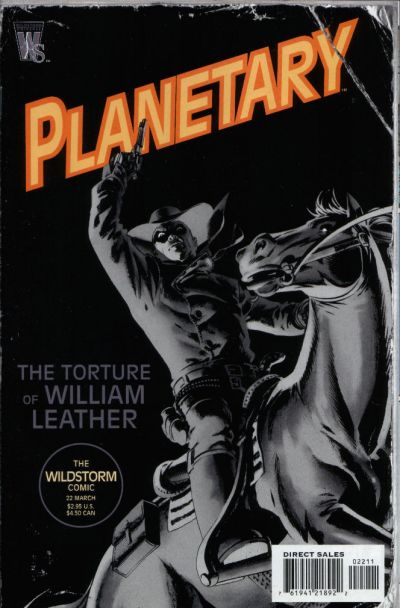In “Death Machine Telemetry”, we have a clear reference to the 60s psychedelia and the LSD subculture; in “The Gun Club”, there is a heartfelt homage to Jules Verne and his “From the Earth to the Moon” novel; in “Opak-Re”, it’s the turn of Edgar Rice Burroughs’ Tarzan; and other chapters focus on kung-fu / karate movies, Godzilla and other B movies, pulp novels, classic horror monsters like Frankenstein and Dracula, James Bond and the world of espionage, DC’s Justice League, Vertigo characters and so on.
In “The Torture of William Leather” (originally published in Planetary # 22, March 2005), the British author decides to pay attention to the Lone Ranger, a character even older than the first superhero. The Lone Ranger was quite popular in radio shows in the early 30s, and eventually books, comic books and even TV series and movies were created. Perhaps westerns are not as much of a hit as they used to be over 80 years ago, but in this opportunity, Ellis reflects on the wild west by sharing with us the past of William Leather.
In “Zero Point”, Jakita Wagner fights against William Leather, this universe’s evil version of Johnny Storm, the Human Torch. But what was William Leather’s past? What is the secret history of his father and grandfather? It’s in this context in which we see the struggle between cowboys and Indians, between cruel and cold men like the Leathers and noble and idealist warriors such as the Lone Ranger.
 |
| Leather |
 |
| Similar to the Lone Ranger... / parecido al Llanero Solitario... |
________________________________________________________________________________________________
________________________________________________________________________________________________
En el transcurso de una década, Planetary se convirtió en un fructífero patio de juegos en el que Warren Ellis y John Cassaday podían explorar constantemente la arqueología de lo imposible mientras revisitaban hitos en la historia del cómic y encontraban conexiones temáticas entre la cultura pop y el noveno arte. Desde el principio, Planetary nunca se limitó a contar el trágico pasado de Elijah Snow y su conflicto con The Four, una versión distorsionada y perversa de los Fantastic Four de Marvel. El pasado de Snow, el pasado de todos, se puede vincular a una variedad de géneros y medios.
 |
| gangsters |
En “La tortura de William Leather” (originalmente publicado en Planetary # 22, marzo de 2005), el autor británico decide prestarle atención al Llanero Solitario, un personaje incluso más antiguo que el primer superhéroe. El Llanero Solitario fue bastante popular en programas de radio a principios de los 30s, y finalmente se crearon libros, cómics e incluso series de televisión y películas. Quizás los westerns no sean tan exitosos como lo fueron hace más de 80 años, pero en esta oportunidad, Ellis reflexiona sobre el salvaje oeste al compartir con nosotros el pasado de William Leather.
En “Zero Point”, Jakita Wagner lucha contra William Leather, la versión malvada de este universo de Johnny Storm, la Antorcha Humana. Pero, ¿cuál fue el pasado de William Leather? ¿Cuál es la historia secreta de su padre y su abuelo? Es en este contexto en el que vemos la lucha entre vaqueros e indios, entre hombres crueles y fríos como los Leathers y guerreros nobles e idealistas como el Llanero Solitario.
 |
| Similar to The Shadow... / parecido a la Sombra... |
El arte de Cassaday establece el tono de “La tortura de William Leather”. Y todo comienza con la hermosa portada, tratada de tal manera que nos recuerda la carátula de una vieja y desgastada novela pulp del Llanero Solitario. Luego tenemos una página muy interesante en la que seis viñetas horizontales son suficientes para ojear las actividades del abuelo de Leather y un indio que bien podría ser Tonto, el fiel compañero del Llanero Solitario. La página de presentación de la versión del Llanero Solitario de este universo es tan poderosa como la portada, pero probablemente mis páginas favoritas son las que muestran la batalla entre los mafiosos y un héroe que es muy similar a la Sombra. Por supuesto, las páginas finales, que no incluyo aquí, también son extraordinarias, en parte porque son violentas e impactantes, pero también porque muestran, muy explícitamente, cómo William Leather es torturado por su captor, Elijah Snow, el líder de Planetary.

There is that interesting trajectory from radio heroes like the Lone Ranger and the Shadow to the superheroes of today. Though so far attempts to bring back those old heroes in movies like The Shadow, The Phantom, or that dreadful Lone Ranger movie of a few days ago haven't really worked.
ReplyDeleteOh yeah, the movies have been incredibly disappointing.
Delete